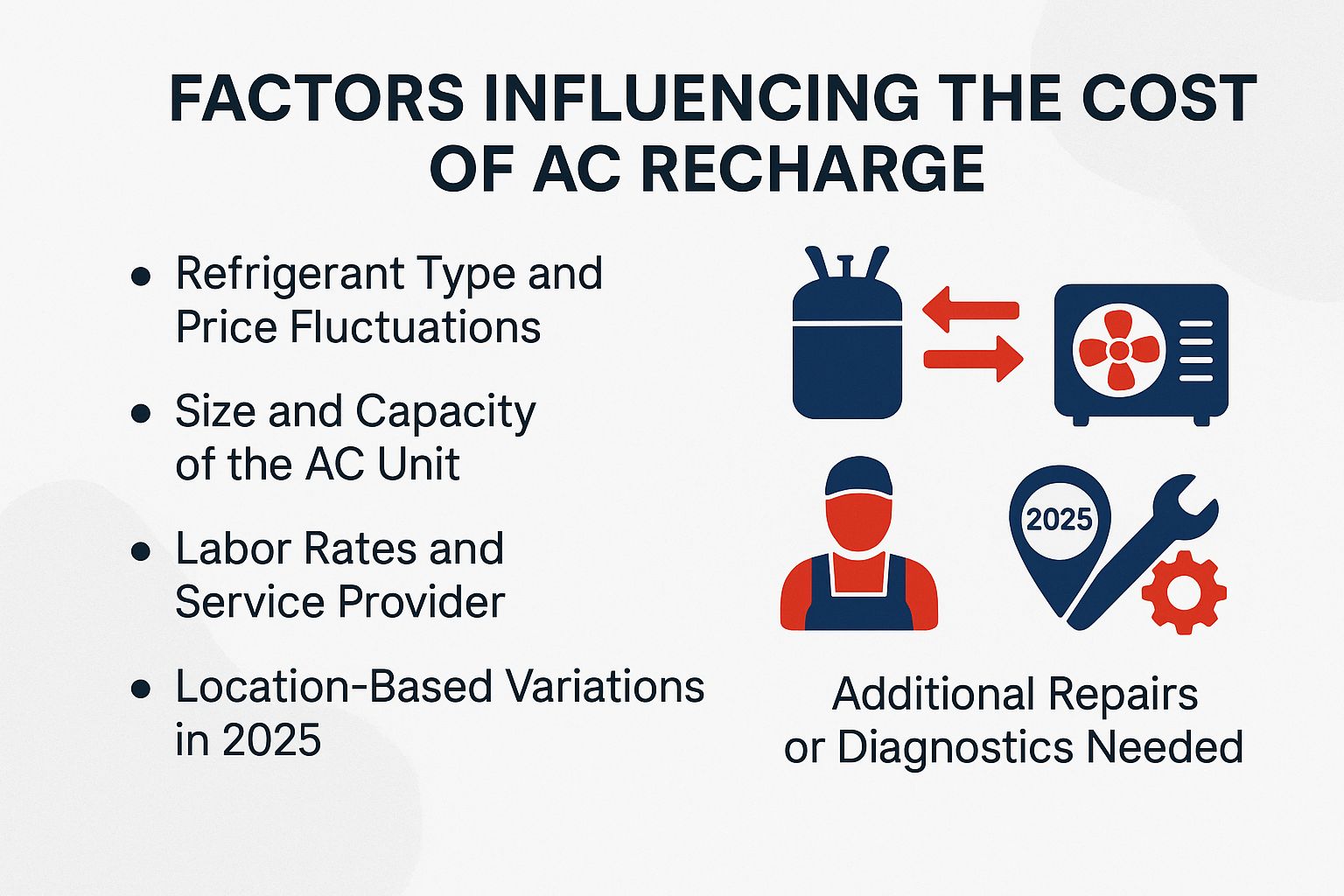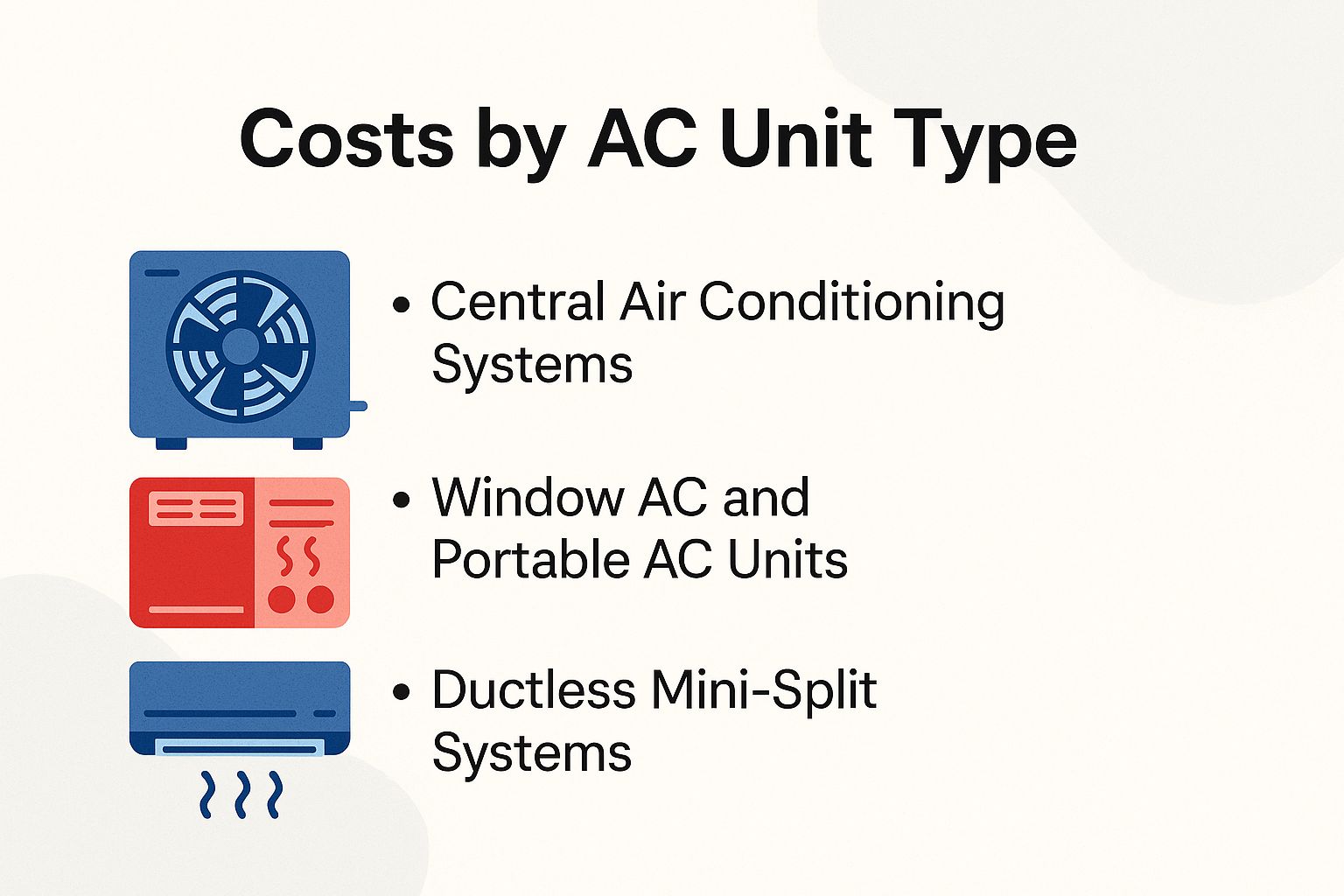
How Much Does It Cost to Recharge an AC Unit in 2025?
Sweat’s beading on your forehead during heatwave preparation, and your air conditioning unit’s blowing warm air-again. In 2025, with refrigerant regs tightening and 2025 prices climbing (per EPA forecasts), an air conditioner refill or freon recharge isn’t cheap, but skipping it could spike your energy bills for home cooling. Dive into what drives AC recharge cost like unit size, R-410A vs. R-32 prices and changes by home location; check average costs for central AC, window AC, portable AC, or mini-split systems; compare hiring professionals versus DIY recharge risks; and learn air conditioner maintenance tips to cut costs.
What is an AC Recharge?
An AC recharge involves adding refrigerant like R-410A to your cooling system’s coils to restore AC performance and cooling efficiency after leaks or normal wear.
Technicians use an AC recharge process based on EPA guidelines Section 608 rules, following safety precautions, and they must get certification to handle materials safely and avoid damage to the environment.
- First, they connect a manifold gauge set to the low- and high-side service ports to measure pressures, identifying if recharge is needed (e.g., low side below 100 psi).
- Next, a recovery machine evacuates old refrigerant into a certified tank for recycling refrigerant.
- The system is then vacuumed to 500 microns using a vacuum pump to remove air and moisture.
- They add exact amounts-usually 2-5 pounds for a 3-ton unit-using a scale to measure correctly.
Visualize the setup: gauges on the manifold show red (high) and blue (low) lines branching to yellow hoses for the recovery unit and vacuum pump.
Why AC Units Need Recharging
Your AC needs recharging when refrigerant levels drop due to leaks in the cooling system, causing symptoms like warm air from vents or ice buildup on evaporator coils or condenser unit.
According to an ASHRAE study, 70% of AC service calls stem from low refrigerant. Here are four common problems and detection methods:
- Corroded lines (prevalent in units over 10 years old): Inspect visible coils for rust; use an ultrasonic leak detector to pinpoint hissing sounds.
- Wear on compressor seals: Listen for unusual noises; perform pressure testing with a manifold gauge set to check for drops below 25 psi.
- Bad setup: Look at flare connections, ductwork, and thermostat for gaps or problems; make sure air filter is clean; put soapy water on fittings and watch for bubbles when pressure is on.
- Loose fittings caused by vibrations: Tighten connections you can reach; use electronic leak detectors that sense R-410A refrigerants to find the exact spot.
Addressing leaks promptly prevents efficiency losses up to 20%.
Overview of Cost Expectations for 2025
In 2025, basic AC recharges start at $200 nationally, but can hit $800 with repairs, driven by 8-12% inflation in HVAC parts.
According to HomeAdvisor, HVAC service costs have risen 15% year-over-year, reflecting supply chain pressures. To budget effectively, consider these ranges:
| Service Type | Cost Range |
|---|---|
| Basic Recharge | $150–$300 |
| With Leak Repair | $400–$700 |
Trends favor R-32 refrigerant adoption, which cuts long-term energy bills by 10-20% per EPA studies, though initial conversions add $200-500. Actionable tip: Always budget 20% extra for diagnostics-use tools like a manifold gauge set ($50) to check pressures yourself before calling pros, potentially saving on service fees.
Factors Influencing the Cost of AC Recharge

Several key cost factors like refrigerant type, unit size, and home location can swing recharge costs from $150 to over $600 in 2025.
Refrigerant Type and Price Fluctuations
In 2025, R-410A refrigerant costs $50 to $80 per pound, which is 15% higher than in 2024 because of that year’s refrigerant phaseout, current environmental rules, and rules set for later. This differs from recharging older systems with R-22 freon, which harms the ozone layer. R-32 costs $40 to $60 per pound, but it needs systems built to handle it. HFO refrigerants serve as options with low global warming potential.
Under the EPA’s AIM Act, HFC production must reduce 40% by 2025, driving R-410A price spikes and shortages.
For bulk refrigerant deals, check suppliers like Johnstone Supply or Ferguson, where R-32 often discounts 10-20% for contractors.
Transition by verifying unit compatibility via manufacturer specs-e.g., Daikin mini-splits use R-32-and stock up before Q3 2025 deadlines for cost savings up to 25%.
Size and Capacity of the AC Unit
A 1.5-ton AC unit needs about 4-6 lbs of refrigerant for a recharge, costing $200-$300, while a 5-ton system requires 10-15 lbs at $500+.
To estimate refrigerant needs for other sizes, use this formula: Tons x 2.5-3 lbs/ton. For example:
- 1-ton: 2.5-3 lbs, $150-$200 base cost
- 2-ton: 5-6 lbs, $250 base
- 3-ton: 7.5-9 lbs, $350 base
- 4-ton: 10-12 lbs, $450 base
Costs vary by refrigerant type (e.g., R-410A at $20-$30/lb) and labor. Per ENERGY STAR guidelines, match BTU to home size-12,000 BTU (1 ton) suits 500 sq ft-to avoid under-sizing, which causes frequent recharges and higher bills (up to 20% inefficiency per EPA studies).
Labor Rates and Service Provider
HVAC market rates for labor cost average $75-$150 per hour in 2025, with NATE-certified licensed technician fees charging 20% more but offering better warranty coverage.
Break down rates by provider type: independents charge around $80/hour for flexible scheduling, while chains like ARS/Rescue Rooter hit $120/hour with guaranteed response times for emergency service.
For a standard AC recharge, expect 1-3 hours of labor, totaling $100-$450.
According to Angi data, hiring certified pros cuts callbacks by 40%, saving time and money long-term.
To save money, get at least three quotes from local technicians through HomeAdvisor-users say they saved up to $100 by comparing choices and bargaining.
Always check for NATE certification to get reliable, guaranteed work that stops breakdowns later.
Location-Based Variations in 2025
In high-cost areas like California, AC recharges average $400, compared to $250 in the Midwest, influenced by urban demand and supply chain.
Regional cost variations are evident across the U.S., per Fixr.com’s 2025 estimates. Urban areas drive premiums due to higher labor rates-BLS data shows West Coast wages 20% above national averages.
| Region | Average Cost Range | Example |
|---|---|---|
| Northeast | $300–$500 | NYC: $450 |
| South | $200–$400 | Rural TX: $220 |
| Midwest | $200–$300 | Chicago: $280 |
| West | $350–$500 | LA: $400 |
Seasonal pricing for summer AC service adds 25% in summer; opt for off-peak hours or cost comparison from local providers and certified techs via Angi to save 10-20%, checking reviews ratings.
Additional Repairs or Diagnostics Needed
Diagnostic fee for diagnostics like leak detection add $100-$200 to your bill, and fixing a compressor issue can push total costs to $1,000+ in 2025 for AC repair.
To manage expenses, consider common add-ons during service. Outline key ones:
- Pressure check ($75) uses gauges to identify pressure drops;
- Nitrogen leak repair costs $150-300 and closes small leaks well.
- Evaporator coil cleaning ($200) involves foam cleaners and vacuums for better efficiency.
For instance, a basic $250 refrigerant recharge can escalate to $550 if coil issues are found.
A Trane study shows 60% of recharges find leaks. It suggests combining services for a system tune-up at 10-15% off, which cuts costs by $50-100 on average and stops return visits.
Average Costs Breakdown for AC Recharge in 2025

Nationally, AC recharge costs in 2025 range from $150 for simple jobs to $600 for complex ones, averaging $300 including labor and materials.
National Average Cost Range
The national average cost for an AC recharge in 2025 is $250-$450, covering 80% of standard residential jobs per HomeAdvisor surveys, including service call fee.
This represents a 9% increase from 2024 averages due to rising refrigerant costs and labor rates, according to the U.S. Energy Information Administration, with inflation impact on market rates.
Costs vary by system type: low-end at $150 for a simple window unit recharge with no repairs; mid-range around $300 for basic central AC service; and high-end over $500 when leak detection and fixes are needed, as per BobVila.com estimates.
A typical cost breakdown includes 35% parts cost for materials (refrigerant like R-410A), 45% labor, and 20% miscellaneous fees.
To get exact quotes, use the free cost calculators on BobVila.com. Enter your location and details about your AC.
Cost by Refrigerant: R-410A vs. R-32
Recharging with R-410A costs $200-$400 total, while R-32 runs $150-$350, thanks to its lower price and efficiency in new units.
Switching to R-32 offers long-term savings and environmental benefits. Here’s a side-by-side comparison:
| Attribute | R-410A | R-32 |
|---|---|---|
| Price per lb | $60 | $45 |
| Total for 5 lbs (refrigerant only) | $300 + labor | $225 + labor |
| Environmental Status | Phasing out by 2025 (high GWP) | Lower GWP, EPA-recommended |
According to EPA data, R-32 provides 20% cost savings over time due to better efficiency. For example, upgrading to R-32 in SEER 16+ AC units saves about $50 annually on energy bills.
Actionable step: Consult a certified HVAC technician to assess compatibility before recharging; this ensures compliance with 2025 regulations and optimizes performance.
Residential vs. Commercial Unit Costs
Residential recharges average $300 for a home central AC unit, but commercial ones hit $800+ due to larger capacities and 24/7 demands. For best practices in preventive maintenance and annual service to extend AC lifespan, consider system tune-up to maintain energy efficiency, comfort level, indoor temperature, and humidity control for improved air quality and allergen reduction. Today’s air conditioners use IoT thermostats and app controls, along with variable speed compressors and inverter technology. They deliver cooling that saves energy and supports long-term heating, ventilation, and air conditioning setups. Look for green certifications, rebate programs, government incentives, and utility rebates from local providers, using cost estimate tools and reviews ratings for troubleshooting common problems in the AC recharge process.
To understand these differences, compare key attributes below. Residential systems (1-5 tons) suit homes with simpler setups, while commercial (10+ tons) demand specialized equipment for offices or large facilities.
Per RSMeans data, commercial rates are often 2x residential due to complexity and refrigerant volumes. For example, the AC recharge cost for an apartment window unit is ~$150, versus $700 for an office packaged system.
Multi-unit buildings may qualify for volume discounts, reducing per-unit costs by 20-30%. Actionable tip: Schedule during off-peak seasons for 10-15% savings; always verify EPA-certified technicians to comply with regulations.
Emergency vs. Scheduled Service Pricing
Emergency AC recharges cost 50-100% more for summer AC service, like $450 vs. $250 for scheduled, especially during summer peaks in 2025.
To avoid these hikes, opt for scheduled services during off-season months like fall or winter, where rates drop to $200-300 with up to 20% discounts from providers like those tracked by ServiceTitan. Their data shows urgent calls command a 40% premium on average due to high demand and technician availability.
For emergencies, after-hours fees add $400-600 plus a $100 rush charge.
A practical tip: Book maintenance in September for $50-100 savings ahead of 2025 heatwaves. For instance, a weekend callout might tack on $150 in travel fees, emphasizing the value of proactive planning and budgeting for AC to keep cooling costs predictable.
Costs by AC Unit Type

Recharge costs that affect AC unit cost vary by unit type, from $100 for window ACs to $500 for central systems in 2025, based on access and refrigerant volume.
Central Air Conditioning Systems
Central AC recharges average $300-$600 in 2025, including 5-10 lbs of R-410A and duct checks for a 3-4 ton unit.
This price typically breaks down to labor (2-4 hours at $100/hour, or $200-$400) for leak detection, system evacuation, and recharging, plus $200 in materials like refrigerant and oil.
The AC recharge process starts with a pressure test to find leaks, followed by vacuuming the system and adding fresh R-410A to manufacturer specs.
Add-ons can increase costs: condenser coil cleaning ($150) or full duct inspection ($100-$200).
For example, a Lennox case study on a 14 SEER unit showed post-recharge energy savings of $200 annually (per ENERGY STAR data).
Beware higher costs for older R-22 systems, adding $100 per lb due to phase-out regulations.
Window AC and Portable AC Units
Window AC recharges cost $100-$250, using 1-2 lbs of refrigerant and basic tools, ideal for quick DIY or pro fixes.
Break down the costs for clarity: refrigerant like R-410A runs $75 per lb, unit removal and access $50, and labor 1 hour at $75-150 for pros. For a standard 8,000 BTU window unit in an apartment, totals often hit $150.
DIY saves money-grab a recharge kit from AutoZone for $40 (if EPA-certified) plus a $30 manifold gauge set from Amazon.
- Power off unit and locate low-pressure port;
- Connect gauges, evacuate air if needed;
- Add refrigerant gradually, checking to 25-35 psi.
Consumer Reports notes window AC fixes cost 30% less than central systems, per their 2023 efficiency study.
Ductless Mini-Split Systems
In 2025, recharging a mini-split system costs $200 to $400 per zone. Multi-head systems that use R-410A require careful vacuuming.
For single-zone systems, expect to use about 3 lbs of R-410A refrigerant, costing around $250 including labor for evacuation and vacuuming to remove moisture.
Multi-head setups require 5-8 lbs, pushing prices to $350 or more due to complex line connections.
These recharges improve AC performance in specific zones, reaching SEER ratings above 20 for cooling in those zones without wasting energy.
A Mitsubishi Electric study shows routine recharges extend AC lifespan by 5 years while cutting lifetime costs 15% below central AC, thanks to ductless design.
Always hire certified pros like NATE technicians to maintain warranty and avoid leaks-DIY risks voiding coverage.
Professional vs. DIY Recharge Options

Professional recharges meet regulations and keep warranties in place, but they cost more than $250. DIY kits lower the price by $100, but they can lead to EPA fines up to $50,000.
Professional Service Costs and Benefits
Hire a pro for $200-$500 to get certified handling, warranty extensions, and leak detection using tools like ultrasonic detectors.
Certified technicians, compliant with EPA Section 608 regulations, safely manage refrigerants to avoid fines up to $50,000 per violation.
They use advanced tools like electronic leak detectors (e.g., Bacharach’s TruPoint, starting at $300) alongside ultrasonics for pinpoint accuracy, often detecting leaks as small as 0.5 oz/year.
Benefits include a 1-year warranty (worth $100), 20% energy savings from optimized systems, and extended equipment life.
For example, OneHour Heating’s service adds insurance coverage for repairs. NATE-certified pros fix 95% of issues on the first visit, per industry data.
Schedule via Angi, provide system details, and insist on a post-service efficiency test to verify improvements.
DIY Recharge: Tools, Materials, and Risks
A DIY AC recharge kit from Amazon costs $50-$100, including gauges and 1 lb R-134a, but only for auto ACs-not home units due to regulations.
Recharging air conditioning systems in vehicles is simple and legal without certification.
- Start by parking in shade and running the engine with AC on max.
- Locate the low-pressure port (blue cap, larger hose) near the firewall.
- Attach the kit’s manifold gauges-aim for 25-35 psi on the low side at 80 degreesF ambient.
- Slowly add R-134a via the can tap, shaking it periodically, until pressures stabilize (avoid over 45 psi to prevent compressor damage).
Popular kits like the Oregon 18 oz ($45) include leak sealant. Per EPA guidelines, this DIY saves $100+ vs. shop service but risks voiding warranties if mishandled-always check for leaks first with UV dye tools ($20).
Legal and Environmental Regulations in 2025
Under 2025 EPA AIM Act, only certified techs can handle HFCs like R-410A, with recycling mandatory to cut emissions 85% by 2036.
To comply, HVAC professionals must obtain Section 608 certification through a $200 EPA-approved course, covering safe handling and leak detection.
Recovery and recycling are essential; invest in machines like the Yellow Jacket RecoverX ($500+) to reclaim refrigerants without release.
The phase-down bans R-22 production, driving prices to $150/lb and shifting to low GWP refrigerants like HFO refrigerants and R-32.
This reduces global warming potential significantly, promoting sustainable HVAC as air conditioners contribute 8% to global emissions per a 2023 UNEP report.
Tip: Always hire certified techs to dodge fines up to $44,000 per day.
Tips for Saving on AC Recharge in 2025

Save 20-40% on 2025 AC recharges by scheduling off-season, claiming rebates and tax deductions, maintaining your unit to prevent leaks, and exploring financing options.
Preventive Maintenance Strategies
Annual AC maintenance like coil cleaning costs $100 but prevents $300 recharges by catching leaks early with simple checks.
To maximize your AC’s efficiency and longevity, adopt these five actionable practices:
- Clean or replace air filters monthly-this simple task, using standard filters ($10-20), can save up to 15% on energy bills by improving airflow.
- Schedule professional coil inspections yearly for about $75; technicians use specialized brushes and vacuums to remove debris that reduces efficiency.
- Monitor refrigerant levels quarterly with a DIY pressure gauge kit ($20 from hardware stores) to detect leaks before they escalate.
- Seal duct leaks using a basic insulation kit ($50), which can prevent 20% of conditioned air loss, as per energy audits.
- Use IoT thermostats with internet-connected AC units, such as the Nest thermostat. It costs $250 and gives up to $100 in rebates from utility companies. It adjusts temperature on its own and lets you check app-controlled AC from a distance.
A U.S. Department of Energy study shows routine maintenance extends unit life by 25%. For instance, one homeowner avoided a $400 AC repair for compressor issues through quarterly checks, proving these steps pay off quickly.
About the Author
I’m Allen Chambers, a master electrician and licensed HVAC contractor with over 20 years of experience helping Florida homeowners design energy-efficient, high-performance HVAC solutions. As a contributor to HVAC Service Cost, I focus on making heating and cooling upgrades more affordable, sustainable, and stress-free for families across the state.




Leave a Reply